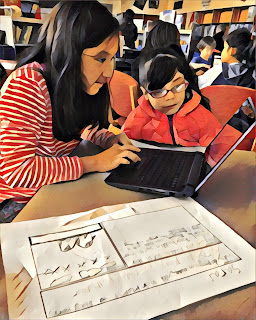The role of educator has changed
significantly since the integration of technology. Teachers are not the
esteemed holders of knowledge as they once were because students’ have a wealth
of information at their fingertips.
There has been talk for years about how the skills of the workforce have
changed and how educators are preparing learners for jobs that do not even
exist. Friedman’s article, “How to Get a Job at Google,” highlights five
attributes of hirable candidates. These
include cognitive ability, leadership, humility, ownership and expertise (Couros, 157). Education is about so much more than reading, writing
and arithmetic. Educators must now
prepare learners to be creative, critical thinkers who flexibly solve
real-world problems across multiple content areas and then communicate
solutions to a wide audience. According to Forbes, 40% of U.S. jobs will be
automated by 2030, “Today’s
kindergartners are the graduating class of 2030, so while the challenge might
seem far off, it is actually
quite urgent.” Luckily, brilliant educators across the globe have felt
that sense of urgency and are accepting this transformational challenge and
making significant changes for learners.
Equity, a key focus of
educators, administrators, superintendents and school boards, isn’t about all
kids – it is about each and every kid. Districts are investing time and
resources to prepare students for college, career and life readiness. As part
of that preparation, educational technology has significantly impacted our
classrooms. For instance, the 1:1
initiative ensures every learner has his/her own device during the school day. In educational technology circles, personalized
learning is the new buzz. The International Association for K-12 Online
Learning, iNACOL, defines personalized learning as,
“Tailoring learning for each
student’s strengths, needs and interests–including enabling student voice and
choice in what, how, when and where they learn–to provide flexibility and
supports to ensure mastery of the highest standards possible” (Abel, 2015). Both 1:1 and personalized learning are
excellent shifts in the direction toward equity and innovation. Technology is a tool and alone, technology will not make
the necessary change. “Learners
are the drivers; technology is the accelerator” (Couros, 2015). The right educational approach is learner
focused; these learners include both educators and students.
In the book, The
Passion-Driven Classroom: A Framework for Teaching and Learning, the
authors discuss the achievement gap in education as a reflection of a gap of
passion rather than achievement. They state:
Students are not falling through the
cracks because our standards are low, or because our classrooms are ill
equipped with the latest technology, or because we failed to use the right book
or strategy. They are falling because we have not yet found a way to sustain
the energy, excitement, and love for learning they came with when they first
entered our classrooms (Maiers and Sandvold 4)
Educational technologies can
support our work in reaching each and every learner and these tools can be
transformational.
Couros references Porter’s three
levels of integration: literate, adaptive and transformative (157). At a literate level, you become familiar with
the tool. Adaptation occurs when the tool helps you do something with the tool
that you used to do without it. Transformation only happens when the tool
allows you to do something new that was not possible without the tool. In order
for learners to get to the transformative stage, it’s important to remember
that less is more (Couros 157). With thousands of apps and technology tools out
there, educators must choose carefully.
Simplicity and focus will help you achieve a true level of
transformation because transformation requires time and creativity. “Creativity
is where we start to think differently, and innovation is where creativity
comes to life” (Couros 158). Being innovative and using technology tools in
transformative ways, we begin to push learners beyond their own limitations to
achieve their fullest potential.
Educational
technologies have changed the face of education and rewritten the age old role
of educators. These technologies are a tool, and yes, some can be
transformative; however, technology doesn’t innovate, humans do. Innovation
isn’t something that happens in a vacuum and it’s not a process to be rushed.
Innovation occurs by fostering a culture of creativity, allowing time for
teachers and learners to move from literate to adaptive to transformative
levels of integration. Make the opportunity to innovate accessible to all. It
is about simplicity, passion and equity. You have what it takes so take that
first step.
Article By: Ashley K. Leneway
Curriculum & Technology Integration
Specialist
Morgen Owings Elementary, Lake Chelan Public
Schools
ashleyleneway@gmail.com
Twitter: @mrsleneway
Works Cited
Abel, Natalie. “What Is Personalized Learning?” iNACOL, 25 Feb. 2016,
Childress, Stacey. “3 Biggest Education Innovation
Questions For 2018.” Forbes, Forbes
Magazine, 9 Jan. 2018,
Couros,
George. The Innovator’s Mindset: Empower
Learning, Unleash Talent, and Lead a
Culture
of Creativity. San Diego, Dave Burgess
Consulting, 2015.
Herold, Benjamin. “The Future of Work Is Uncertain, Schools Should Worry Now.” Education
Week, 1 Mar. 2018,
Maiers, Angela, and Amy Sandvold. The Passion-Driven Classroom: a
Framework for
Teaching and Learning. Routledge, 2018.



